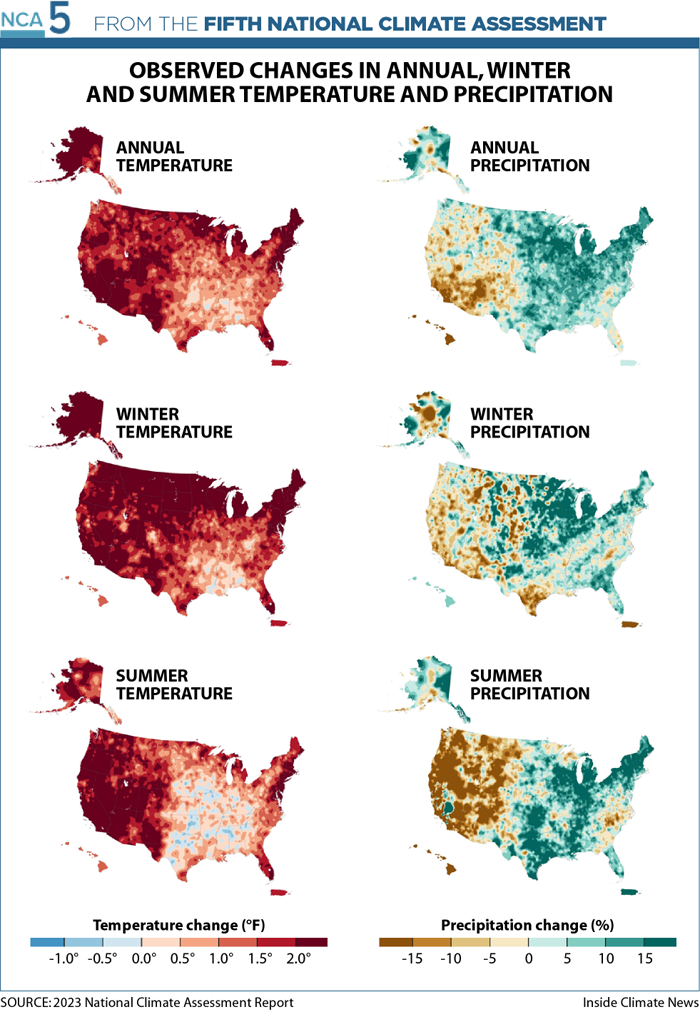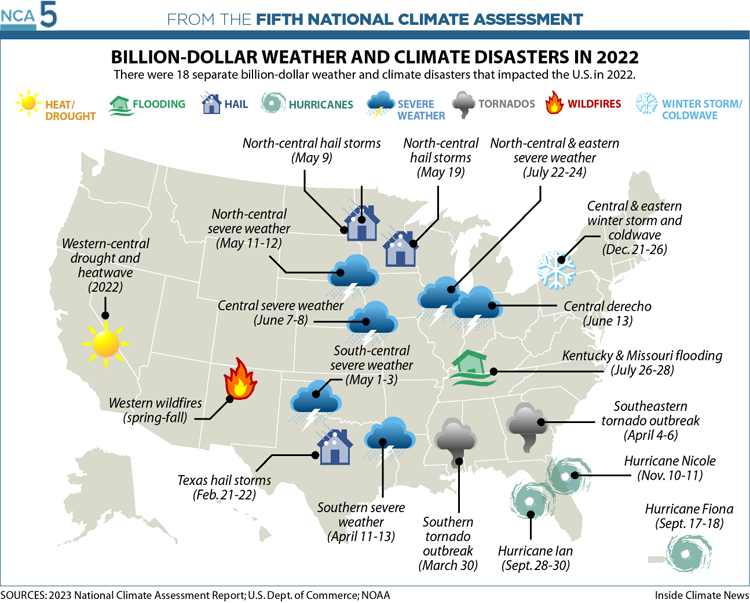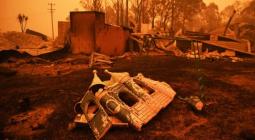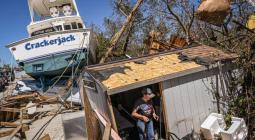US Regions Will Suffer a Stunning Variety of Climate-Caused Disasters, Report Finds

Extreme temperatures; worsening wildfires, hurricanes and floods; infrastructure problems; agricultural impacts: The way you experience climate change will depend on where you live.
If there is one overarching message from the nation’s latest climate assessment, it is that nowhere will be spared.
Hotter temperatures are coming to every corner of the country, as are weather extremes. Many regions are experiencing more frequent, heavier rains, while others are seeing worsening drought. Some are getting both. Everywhere, these changes are translating into greater stresses on Americans’ health through worsening heatwaves, wildfires, hurricanes, floods and the psychological toll of mounting disasters.
“There is not a part of the U.S. that gets a pass on climate impacts,” one Biden administration official said during a briefing for reporters on the Fifth National Climate Assessment, or NCA. The sprawling, peer-reviewed federal report, released Tuesday, is mandated by Congress and provides the most comprehensive look at the state of climate change across the country.
How those impacts show themselves will vary greatly, with each region suffering its own particular plagues. For extreme precipitation and the floods it unleashes, the official said, the Northeast has some of the worst. In the Southeast, where hotter temperatures marry with stifling humidity, residents and those working outside are struggling with some of the nation’s worst extreme heat. Out West, wildfires and drought are poisoning the air and parching fields and taps. Across the Midwest, floods, droughts and extreme heat are disrupting farmers’ livelihoods and traditions. Along the coasts, high-tide flooding is worsening almost universally as rising seas inundate neighborhoods.

The assessment highlights that these impacts are falling disproportionately on less wealthy communities and Black and Indigenous Americans and people of color. In the Southeast, for example, the report says that “the institutions of slavery and intergenerational ownership of individuals as property” have meant that Black people and other people of color “are disproportionately exposed to environmental risks and with fewer resources to address them when compared to majority White communities.” Other regions, the report says, have their own inequities.
States in all regions have begun efforts to cut their climate pollution and adapt to the impacts of climate change, according to the assessment, with the greatest number of actions coming in the Northeast and Southwest, a region that includes California.
On Tuesday, the Biden administration accompanied the report with an announcement of $6 billion in funding to help those efforts. The nation’s electric grid will get $3.9 billion to help protect it from climate impacts, while $2 billion will go toward community-driven projects on clean energy and climate resilience.
Already, billion-dollar disasters are striking most every region of the country, on average, one every three weeks, with particular concentrations along the coasts and in many Midwestern states. If warming continues unabated, the report makes clear, those disasters will worsen everywhere.

People Moving “Into Harm’s Way” in the Southeast
Every state in the Southeast except Mississippi experienced population growth during the past decade, even as the region historically has suffered more billion-dollar disasters than the rest of the country. Since 2018, the region has also weathered multiple hurricanes, researchers wrote.
The population growth in the Southeast exposes more communities to climate impacts like hotter temperatures, rising seas and more damaging hurricanes. Meanwhile, decision-makers have tended to develop adaptation plans based on outdated or limited information that fails to account for future risks.
”We’re moving more people into harm’s way, and we’re not doing it in a very coordinated way,” said Kathie Dello, state climatologist in North Carolina and director of the North Carolina State Climate Office. One of the co-authors of the study, she spoke Wednesday on a call with journalists. “Our cities just aren’t moving fast enough to keep up with climate change.”
Most vulnerable are low-income communities and communities of color. The region is home to more Black residents than any other in the country, and these residents face disproportionate risks for health-related impacts. Residents of color tend to have less access to health care, nutritious food and safe places to exercise and also are vulnerable to other disparities involving education and employment.
PHOTO: A recovery vehicle drives past burned structures and cars two months after a devastating August wildfire in Lahaina, Hawaii. The wind-whipped conflagration on Maui killed 97 people while displacing thousands more and destroying over 2,000 buildings in the historic town, most of which were homes. Credit: Mario Tama/Getty Images





